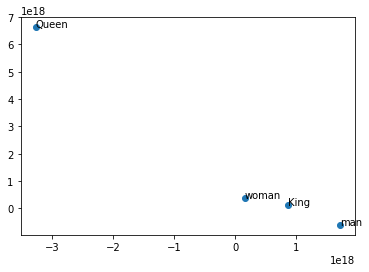NLP: Get hands dirty with Word2Vec
Last time I wrote a post about words co-ocurrences matrix: basically why do we need it and how to create it, along with taking advantage of SVD to reduce dimensions. In this quick post, I will go directly to the implementations of Word2Vec in the package gensim. No math, no lengthy formulas, as I believe there are tons of useful resources online regarding the Skip-Gram Model and Continuous Bag-of-Words Model inside and out. Here is someone’s collection of links and notes, all about Word2Vec. That’s why this post is only focusing on getting some hands-on practice in Word2Vec.
Word2Vec implementations
Word2Vec is part of the gensim package, and it is only one of many possible embeddings. You can find the documentation here
import gensim.models.word2vec as w2v
# load data
books = [open('../data/dorian.txt','r', encoding = 'utf8'),open('../data/earnest.txt','r'),
open('../data/essays.txt','r'),open('../data/ghost.txt','r'),
open('../data/happy_prince.txt','r'),open('../data/house_pomegranates.txt','r'),
open('../data/ideal_husband.txt','r'),open('../data/intentions.txt','r'),
open('../data/lady_windermere.txt','r'),open('../data/profundis.txt','r'),
open('../data/salome.txt','r'),open('../data/soul_of_man.txt','r'),
open('../data/woman_of_no_importance.txt','r')]
# make it as a large corpus
corpus = " ".join([book.read() for book in books])
Same as last time, we use package nltk to help us create sentences.
from nltk import sent_tokenize
raw_sentences = sent_tokenize(corpus)
# print one of the sentences
raw_sentences[5005]
Randomly print out any one sentence. What I got is as follows: "Everybody I know says you are very wicked," cried the old lady, shaking her head.
To create a model we need to feed it a list of sentences, of importance for us within the signature are
- sentences = List of sentences, where each sentence is a list of tokens (words).
- size: Which corresponds to the embedding dimension, default = 100.
- window: The number of words before and after, default = 5. (8 works better according to the paper)
- min_count: Ignores words that appear less than this number where the choice is depending on how large is your training document
So now we need to make each raw sentence into a list of tokens.
from nltk import word_tokenize
sentences = []
for sentence in raw_sentences:
sentences += [word_tokenize(sentence)]
# sentences is a list of list
sentences[20]
# you should get:
# ['No', 'artist', 'has', 'ethical', 'sympathies', '.']
Alright, everything is ready, let’s train our first model!
model_1 = w2v.Word2Vec(sentences = sentences, size = 40, window = 8)
Let’s check out any random word, for say, let’s see how the model translates word ‘love’ into a 40-dimension vector.
# convert love to size 40 vectors
model_1['love']
What if you specify some word not existing in the document? The short answer is that you will get errors, however, there are some parameters you can specify, basically looking for the most similar word’s numeric representations, to avoid this kind of errors. Also one thing you need to remember is that they are case sensitive. Let’s prove it by the following codes.
# case sensitive
model_1['Love'] == model_1['love']
Test the model on the classic example.
model_1.most_similar([model_1['Queen']-model_1['woman']+model_1['man']])
It’s hardly believe you will end up with word ‘King’ due to the small training size. However, if we turn to pre-trained Word2Vec models, things are much better there.
Visualization is important! Here we are using tsne to visualize text data in 2-D space, isn’t it amazing?
import numpy as np
from sklearn.manifold import TSNE
import pandas as pd
import matplotlib.pyplot as plt
%matplotlib inline
vocab = list(model_1.wv.vocab)
X = model_1[vocab]
tsne = TSNE(n_components=2)
X_tsne = tsne.fit_transform(X)
df = pd.concat([pd.DataFrame(X_tsne),
pd.Series(vocab)],
axis=1)
df.columns = ['x', 'y', 'word']
df = df.query("word in ('King', 'Queen', 'man', 'woman')")
fig = plt.figure()
ax = fig.add_subplot(1, 1, 1)
ax.scatter(df['x'], df['y'])
for i, txt in enumerate(df['word']):
ax.annotate(txt, (df['x'].iloc[i], df['y'].iloc[i]))

Use GoogleNews pre-trained model
There are many Word2Vec pre-trained models out there, here I am only demonstrating GoogleNews one. The pre-trained model can be downloaded from the official website.
from gensim.models.keyedvectors import KeyedVectors
model_2 = KeyedVectors.load_word2vec_format('../data/GoogleNews-vectors-negative300.bin.gz', binary = True)
model_2.most_similar([model_2['Queen']-model_2['woman']+model_2['man']])